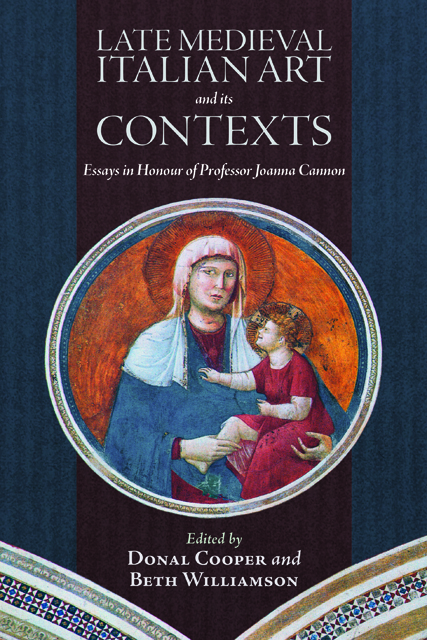Book contents
- Frontmatter
- Contents
- List of Illustrations
- List of Contributors
- Acknowledgements
- List of Abbreviations
- 1 Introduction: Circling Giotto
- 2 Holy Wood / ‘sacra tavola’: Saint Dominic and the Memory of Miracles in Bologna
- 3 The Sculpted Saint: A Statue of Saint Francis in Siena
- 4 Guccio di Mannaia and the Concept of a ‘Franciscan’ Chalice
- 5 ‘Speculum sine macula’: The Trittico di Santa Chiara in Trieste as an Object of Clarissan Devotion
- 6 The Siena Connection: A Franciscan Provincial Minister between Tuscany and Assisi at the Dawn of the Trecento
- 7 Simone Martini’s ‘Treaty with the House of Santa Fiora’ in Siena’s Palazzo Pubblico: Its Date and Significance
- 8 Crisis and Charity in Fourteenth-Century Florence: Ambrogio Lorenzetti’s Saint Nicholas Panels for San Procolo
- 9 Father of Light: Giotto and the Beatific Vision in the Baroncelli Chapel
- 10 Painter-Illuminator Workshops and the Church of San Giorgio a Ruballa: The Case of Bernardo Daddi and Pacino di Bonaguida
- 11 Patterns of Holiness: A Virgin Lactans in a Franciscan Context
- 12 A New Angle on Simone Martini’s Holy Family
- 13 Artistic Appropriation, Institutional Identity, and Civic Religion in Fourteenth-Century Siena: The Byzantine Treasury of the Hospital of Santa Maria della Scala
- 14 Visual Religious Education in Late Medieval Florence: Zanobi Perini, The Leggenda di Santo Tobia, and The Misericordia
- 15 Saints and Status in Late Medieval and Early Renaissance Florence
- Select Bibliography
- Publications by Joanna Cannon
- Index
- Tabula Gratulatoria
- Backmatter
5 - ‘Speculum sine macula’: The Trittico di Santa Chiara in Trieste as an Object of Clarissan Devotion
Published online by Cambridge University Press: 20 December 2022
- Frontmatter
- Contents
- List of Illustrations
- List of Contributors
- Acknowledgements
- List of Abbreviations
- 1 Introduction: Circling Giotto
- 2 Holy Wood / ‘sacra tavola’: Saint Dominic and the Memory of Miracles in Bologna
- 3 The Sculpted Saint: A Statue of Saint Francis in Siena
- 4 Guccio di Mannaia and the Concept of a ‘Franciscan’ Chalice
- 5 ‘Speculum sine macula’: The Trittico di Santa Chiara in Trieste as an Object of Clarissan Devotion
- 6 The Siena Connection: A Franciscan Provincial Minister between Tuscany and Assisi at the Dawn of the Trecento
- 7 Simone Martini’s ‘Treaty with the House of Santa Fiora’ in Siena’s Palazzo Pubblico: Its Date and Significance
- 8 Crisis and Charity in Fourteenth-Century Florence: Ambrogio Lorenzetti’s Saint Nicholas Panels for San Procolo
- 9 Father of Light: Giotto and the Beatific Vision in the Baroncelli Chapel
- 10 Painter-Illuminator Workshops and the Church of San Giorgio a Ruballa: The Case of Bernardo Daddi and Pacino di Bonaguida
- 11 Patterns of Holiness: A Virgin Lactans in a Franciscan Context
- 12 A New Angle on Simone Martini’s Holy Family
- 13 Artistic Appropriation, Institutional Identity, and Civic Religion in Fourteenth-Century Siena: The Byzantine Treasury of the Hospital of Santa Maria della Scala
- 14 Visual Religious Education in Late Medieval Florence: Zanobi Perini, The Leggenda di Santo Tobia, and The Misericordia
- 15 Saints and Status in Late Medieval and Early Renaissance Florence
- Select Bibliography
- Publications by Joanna Cannon
- Index
- Tabula Gratulatoria
- Backmatter
Summary
In 1895, the Triestine physician Antonio Lorenzutti gave a precious fourteenth-century painted triptych with foldable wings on permanent loan to his local town museum. The object had been given to him by the Benedictine nuns of San Cipriano in Trieste, as a thank-you for the free medical services he had provided for their community over the years. In 1907, Lorenzutti’s family bequeathed the triptych to the municipality of Trieste; currently displayed in the Civico Museo Sartorio, it still forms part of the city’s art collections (Plate V).
Since its transition from female monastic clausura to museum context, the triptych has played an important part in the historiography of Venetian Trecento panel painting. Its wings, especially, believed to be early works by Paolo Veneziano, have received a considerable amount of attention, and have mostly been discussed in the context of his workshop production and artistic development. Most scholars now date the wings to c. 1328–30, and very plausibly argue that they were added to the slightly older central panel, painted c. 1300–20, in a second stage of development.
In addition, iconographic studies have mainly focused on the images depicted on the wings and linked them to the early history of the Benedictine nuns of San Cipriano in Trieste, from where the triptych emerged at the end of the nineteenth century. Before moving to the premises of the church of San Cipriano in 1458, the community, then operating under the name of Santa Maria della Cella, went through a period of relative institutional fluidity. A ‘Cella dominarum Sancte Marie’, probably a semi-religious group, mentioned in the documents in 1265, was transformed into a monastic house by the Triestine bishop in 1278, and from at least 1282 belonged to the Ordo Sanctae Clarae, the female branch of the Franciscan Order as instituted by Pope Urban IV (r. 1261–64). This institutional shift – the reasons for which are unknown – caused serious differences between the community of Santa Maria della Cella and the Triestine bishop, which were only settled in the years around 1330. Maria Walcher Casotti suggested that the scenes on the triptych’s right wing, in particular the one in the middle register showing how Saint Clare and Saint Agnes present a group of young women to a bishop saint, may be connected to the community’s reconciliation with the Triestine Episcopal See.
- Type
- Chapter
- Information
- Late Medieval Italian Art and its ContextsEssays in Honour of Professor Joanna Cannon, pp. 69 - 88Publisher: Boydell & BrewerPrint publication year: 2022



